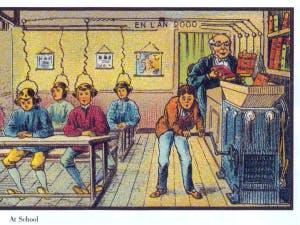Micro eLearning Revolution

At the turn of the twentieth century, French artist Jean-Marc Côté visualized a futuristic vision of a classroom in the year 2000. At School, shown at the 1900 Paris World Exhibition, depicts a brave new world of mass education that harnessed the power of technology and automation, with the teacher now a machine operator, and students passive vessels ready to ‘receive’ information.
Jean-Marc Côté’s futuristic vision of education in the year 2000: At School (1900)

Jean-Marc Côté paints a picture of a false revolution, not dissimilar to the advent of eLearning in the workplace and higher education. Similar to antiquated classroom practices, traditional macro eLearning methods reflect a model of instruction that is passive rather than active; it’s about showing and telling rather than involving.
Similarly, in schools up until the 1960s and 70s, student-automatons were required to regurgitate data and facts without question. In this ‘factory’ or ‘banking’ system of education, engaging students was not the main game, and nor was the fostering of soft skills, such as problem-solving and critical thinking, now highly valued in our knowledge economy. Eventually, educational theory and what was happening in classrooms caught up to the demands of a changing society and workplace. Students were humanized, their experiences mattered, and their powers of critical thought became paramount. A progressive education revolution was taking place and articulated by pedagogical theorists such as Paulo Freire and John Dewey, who reframed education as a tool of empowerment and social transformation.[1] It was a revolution in every sense of the word.
Take a look at any lesson plan these days. Good teachers intuitively hook students in at the start of a class by linking content to the real world. Good teachers will set precise and measurable learning goals, and chunk down content and application activities into bite-size pieces, ideally into ten-minute segments or less. Microlearning in action.
Traditional eLearning
We are starting to see that online training doesn’t always equate to quality learning and employee engagement. Far too often, traditional eLearning perpetuates a cycle of learning that is rote and disengaged—hardly worth the 00 odd billion that is poured into it annually across the globe. A recent McKinsey study calls into question the ROI of traditional eLearning professional development, with only a quarter of respondents perceiving measurable improvements.[2]
Without throwing the baby out with the bathwater, microlearning could be the answer. For the learner, the most noticeable difference between traditional macro eLearning and microlearning is convenience—in both size and delivery. Mobile learning management systems (LMS), such as EdApp, are concise, relevant, and timely. Its bite-sized nature addresses the most frequently cited pain points of traditional macro eLearning—it lacks relevance, it’s time-consuming, and can be overwhelming.
The Microlearning Elearning Revolution
Dig a bit deeper and you’ll see that microlearning is not just about size, with its benefits far exceeding ease of use. Content is meticulously dissected and sequenced into self-standing areas of learning. It is about precision rather than ‘dumbing down.’ Think of microlearning lessons like stations on a train loop network that interconnect and allow the student to double back. Moreover, companies are not ‘locked’ into a particular route either. By analyzing engagement and learning metrics, hotspots that need additional attention can be identified, and companies can detour onto a revised route.
Microlearning brings the Goldilocks principle to the world of eLearning, guided by the ‘just in time’ and ‘just enough’ rules. Unlike traditional structures, where learning material can very often be arbitrary, microlearning content is presented at the right time when employees are primed to learn. With custom content features, the opportunities are endless, from time-released training and onboarding to on-the-job training.
Microlearning does not replace human interaction, far from it; rather, the flexibility of microlearning provides serves to enhance face-to-face learning experiences. It’s clear why sectors such as the health care industry have been some of the earliest adopters of micro eLearning methods. Combining mobile microlearning with placement learning has tangibly enhanced professional engagement and improved clinical competency.[3] Furthermore, microlearning platforms such as EdApp facilitate interactions within and across teams through the use of social learning features, peer learning, and authoring tools. This, combined with an injection of competition through games, leaderboards, and rewards, transforms training into team-building activities, proving that education is not just learning for learning’s sake.

High-engagement, learner-centered, bite-sized content not only enables learners to better retain information but has much stronger outcomes in the transfer and transformation of knowledge. We have come to understand over the years that rote learning provides very little long-term gain for much short-term pain. Any eLearning platform needs to contend with the fact that we are dealing with humans, not machines, and as the Ebbinghaus Forgetting Curve indicates, on average we forget 80 percent of any new content learned within a thirty-day period.[4]
Short revolving cycles of microlearning, using spaced repetition, significantly upgrades our human hardware’s capacity to learn. One widely cited study in the Journal of Applied Psychology found that transfer of learning in microdoses was 17 percent more efficient than traditional long-form instruction.[5] Transfer, application, and creation should be the end goal, not just retention. Not only do we want our employees to be able to remember and transfer new knowledge, but we want them to reapply, modify and recreate their understandings in different scenarios.[6] It’s the creative higher-order thinking where the magic happens.[7]
There’s no doubt that microlearning gives learners the biggest bang for their educational buck in terms of providing training that is both nutritious and palatable (or even, delicious). Think of the ever-popular Crash Course YouTube channel, offering its own style of microlearning (from astrophysics to World History) in the form of episodic content as engaging as any hit Netflix series.
Variation is key
Even before adding infographics, interactivity, games, humor, or animations, content that is precisely focused, learner-centered, and targets an optimal cognitive load, is exponentially more engaging than traditional eLearning. It’s a no-brainer when you look at engagement and satisfaction rates. It’s unsurprising that 94% of professionals reported in one study by the Rapid Learning Institute that they preferred microlearning to more traditional long-form courses.[8] Moreover, engaging learning is effective learning.
Microlearning is often touted as catering to the supposedly diminishing attention spans of an increasing number of millennial employees in the workplace. Undoubtedly, microlearning is in sync with our on-demand society and fast-paced professional world. Put simply, though, microlearning is better for everyone, millennial or not. The convenience of microlearning is a happy by-product of a system that creates more authentic learning environments and more engaged employees.
[1] See Paulo Freire (1990). Pedagogy of the Oppressed, New York: Continuum; John Dewey (1916). Democracy and education: An introduction to the philosophy of education, New York: Free Press.
[2] Aaron De Smet et al. (October 2010) ‘Getting more from your training programs,’ McKinsey Quarterly, available online, https://www.mckinsey.com/business-functions/organization/our-insights/getting-more-from-your-training-programs, retrieved 22 April, 2020.
[3] Gillian Maudsley et al. (2019) A Best Evidence Medical Education (BEME) systematic review of: What works best for health professions students using mobile (hand-held) devices for educational support on clinical placements? BEME Guide No. 52, Medical Teacher, 41:2, 125-140, available online, https://www.tandfonline.com/doi/full/10.1080/0142159X.2018.1508829?af=R&, retrieved 22 April, 2020.
[4] See Hermann Ebbinghaus (1913). Memory; a contribution to experimental psychology. New York city: Teachers college, Columbia University.
[5] Karla Gutierrez (2018). ‘Numbers Don’t Lie: Why Microlearning Is Better for Your Learners (and You Too),’ SHIFT eLearning Blog, available online, https://www.shiftelearning.com/blog/numbers-dont-lie-why-bite-sized-learning-is-better-for-your-learners-and-you-too, retrieved 22 April, 2020.
[6] See Spectrum of Knowledge Transfer in Pooja K. Agarwal and Steven C. Pan (2018). Retrieval Practice and Transfer of Learning: Fostering Students’ Application of Knowledge. UCSanDiego, NSF, available online, http://pdf.retrievalpractice.org/TransferGuide.pdf, retrieved 22 April, 2020.
[7] See Donald R. Clark (1999). ‘Bloom’s Taxonomy of Learning Domains,’ available online, http://www.nwlink.com/~donclark/hrd/bloom.html, retrieved 22 April, 2020.
[8] Michael Boyette (2012). front, available online, https://rapidlearninginstitute.com/news/rli-survey-bite-size-learning-hot-astd-conference-execution-lagging-back-home-front/, retrieved 22 April, 2020.
Author
